BIOFUNGICIDE AQ10
Have a question?

BIOFUNGICIDE AQ10
Dettagli
Used AQ10 , the fungicide based on Ampelomyces quisqualis Intrachem Bio Italia , against the overwintering organs of powdery mildew (the cleistothecia ). From numerous studies (some very recent carried out in collaboration with the Catholic University of Piacenza ) it appears, in fact, that interventions with AQ10 carried out both pre-harvest and post-harvest significantly reduce the infection, even by 50-70%. of powdery mildew in the following year. This is achieved with a dual action.
The first (and perhaps most important) occurs in the powdery mildew mycelium . Normally, winemakers stop treating powdery mildew starting from veraison (in fact, when the grapes have a Brix content higher than 8 they are no longer susceptible to attack by the pathogen); however, powdery mildew does not 'disappear', but remains active above all in the young part of the vegetation (especially on the females) where, if the thermo-hygrometric conditions allow it, it actively reproduces and gives rise to the wintering organs which can be the cleistothecia, or, in southern environments, only the overwintering mycelium. Precisely in this phase the treatment with AQ10, no longer 'disturbed' by negative interferences of anti-downy mildew treatments, is able to act best and reproduce against powdery mildew, drastically lowering the population of the pathogen so as to reduce its overwintering potential . A couple of interventions with AQ10 (30 g/ha) from the period after veraison until harvest are aimed precisely at this objective. Among other things, with this strategy the last treatment with sulfur is replaced and unwanted effects on alcoholic fermentation are avoided. Treatments with AQ10 must be performed during the month of August; if the treatments are carried out towards the evening (and if the product is kept in water for 'pre-germination' for at least an hour) there are absolutely no problems due to high temperatures.
The second action instead occurs on the wintering cleistothecia which can be parasitized ; cleistothecia are susceptible to parasitization by A.quisqualis only when they are in the development phase (and therefore yellow-green in colour, while the darker ones are already fully mature). In the following spring, new spores of A.quisqualis will germinate from the parasitized cleistothecia and not infectious ascospores of powdery mildew. Precisely to increase the percentage of parasitized cleistothecia, it is recommended (in addition to pre-harvest interventions) also to intervene post-harvest (always at a dosage of 30 g/ha) during the month of September , also based on the seasonal trend and the appearance of the first cleistothecia on the leaves.
In conclusion, 2-3 interventions with AQ10 between the harvest ensure a reduction in the powdery mildew inoculum for the following year , without any interference on the quality of the wine (if, indeed, the last treatment with sulfur is replaced, there may also be substantial improvements in quality). This strategy is interesting not only for organic farmers , but also in integrated pest management programs, as it introduces a new means with a different mode of action which significantly reduces the risks of developing populations resistant to conventional fungicides.
|
COMPOSITION:
|
|
Waiting time: |
|
|
||
|
|
|
FIELDS AND DOSES OF USE |
||
|
CULTURE |
DOSAGE |
NOTE |
|
|
|
Treatments from vegetative growth to harvest. |
|
TABLE GRAPES |
50-70 g/ha |
It is advisable to mix it with an adjuvant such as |
|
CUCURBITACEE: |
|
|
|
ROSE |
35-70 g/ha |
It is advisable to mix it with an adjuvant such as |
|
|
||


